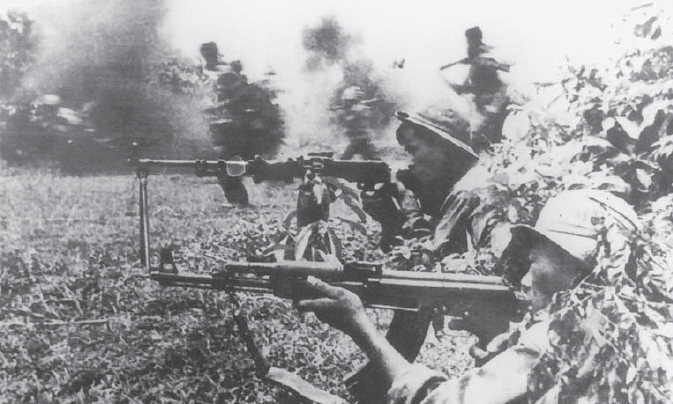
Whilst still in the North, typical NVA replacements would often walk for days from one base camp to another before reaching their new company, where they were welcomed and assigned to platoons. Some units made a small celebration of it. After major operations and the inevitable losses, squads had to be rebuilt and cells re-established. This came before all else, before the reconstituted unit commenced training.
While not considered an initiation (in a way it actually was), the new men underwent self-criticism along with the veterans. The recent infiltrators were expected to tell of their mistakes and the times when their will faltered during the trip south.
The new arrival found training in Cambodia different. In a way it was more informal, but practical. The instruction was obviously presented by men who had done exactly what they were teaching. There was no theory or rigid percepts here.
Anti-helicopter training was an example. It was apparent to the new arrivals that helicopters were something that veterans respected and even feared. They first learned the different types from a little newsprint booklet of poor quality photographs. The most dangerous was the “skinny helicopter,” the Kobra. There were others almost as dangerous and difficult to tell from a distance from helicopters just carrying American or puppet troops.
A veteran with artistic talent sketched silhouettes of the different helicopters on the back of puppet government propaganda posters and these were pinned to the walls of a hut. A cadre member pointed out the vulnerable points on each type – the engine, fuel tanks, pilots’ compartment, door gunners. They were taught how far ahead of the helicopter they were to aim allowing for its speed, range and angle of approach. The next step was for cardboard silhouettes attached to a cord strung between trees to be pulled across a clearing for non-firing lead practice. They were cautioned not to fire on helicopters unless they were obviously going to attack or were landing to deliver or pick up troops.

NVA assault tactics used little in the way of fire and maneuver. The assault would be preceded by mortar, recoilless rifle, rocket and machine-gun fire as well as infiltration by sappers. The assault would comprise a suicidal rush with some troops providing covering fire, as shown here from an AK-47 and an RPD.
The replacements were surprised to learn they were assigned to the 9th Division, officially a VC formation, and were equally surprised that well over half its strength consisted of NVA troops, even more than this in their 272 Regiment. The division had taken a beating during the combined US and ARVN Operation Junction City lasting from February to May 1967.
No one knew how many men the battalion had lost, but the then 102-man company had lost 16 dead and 22 wounded. Five of those who died had perished from combat wounds. Almost a third of the wounded had not returned to the company. With the replacements the company now numbered 118 and a weapons platoon was raised with two 60mm mortars and a 57mm rifle. The battles were spoken of in whispers. The cadre did not like them to be discussed as to do so might be construed defeatist. Little was actually known about the company’s history. There were perhaps six cadre and soldiers who had been in the company for about two years, during which the battalion had fought five battles. This gave an uncomfortable idea of one’s life expectancy. NVA units often only conducted between one and three operations a year and actually saw less action than American units, who spent most of their time in the field.
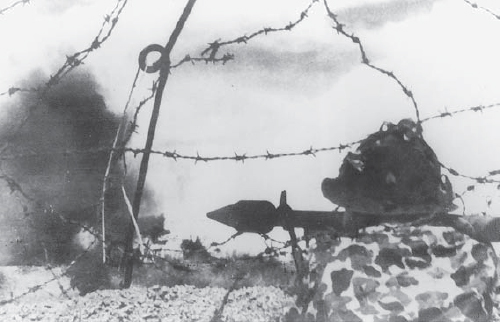
RPG-2 and 7 antitank weapons were excellent fire support weapons for the assault. They would be directed mainly at perimeter bunkers and other defensive positions and fired at a high rate. This RPG-2 gunner wears a parachute-cloth camouflage cape.
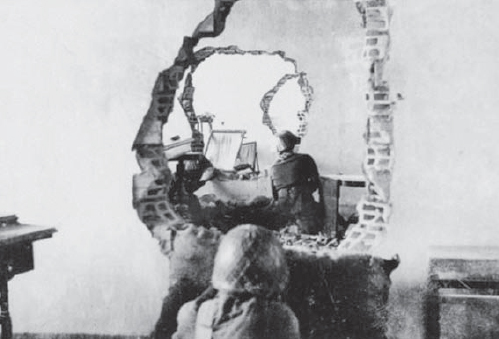
Hue, 1968. Despite being trained only in jungle warfare, the NVA proved difficult to dislodge from buildings in South Vietnam’s econdlargest city. Here they have blasted openings in the internal walls of this building, allowing them to maneuver between rooms.
Base camp life was rather relaxed in spite of training and endless work details. The day began at 5:00 a.m. with a stand to, cooking, breakfast and clean up. Training began at 7:00 a.m. and might consist of weapons or tactics practice, political study and constructing bunkers and fighting positions. The troops rested and had a light lunch from 11:30 a.m. to 1:30 a.m. in the day’s heat. More training followed until 6:30 p.m., usually of a lighter nature due to the afternoon heat. Supper followed with a one-hour break. Training resumed from 8:00 p.m. to 10:00 p.m., often construction tasks. Guards were also posted and security patrols were conducted continuously. There were many work details, such as assisting cooks, camp clean up, digging latrines, hauling water, refreshing camouflage and being sent to the battalion camp to pick up rations, supplies and ammunition. Companies established their own secret supply caches, fearing enemy action and weather would disrupt regular supplies.
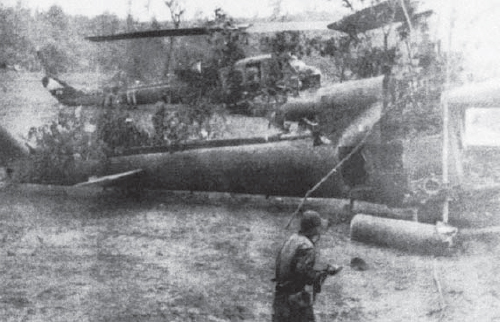
NVA troops overrun an ARVN airbase, where rocket-armed Huey helicopters are still parked, in what is probably a staged scene. The helicopters rest on their tails, which is not normal and there is other obvious damage.
Patrols would visit local Cambodian villages, and there were crossroads at which merchants sold food, soap, cigarettes, lighter flints, utensils, batteries and other basics. The company combined part of the pay and food allowance of its men to make purchases. The ad hoc markets were awash with Cambodian, Vietnamese, Chinese and Laotian merchants, local shoppers and prostitutes. There have been reports of NVA prostitution units, recruited locally, but this has never been verified and was counter to the party’s puritan stance. Although seriously condemned, some NVA female medical personnel and VC females ran their own prostitution rings.
One day the company commander accompanied a patrol to the battalion camp and they returned without him. He returned with a ration detail three days later and immediately called the deputy and platoon commanders. They talked for hours occasionally calling in certain veteran squad commanders. The next day 3 Platoon was sent to a low hill 1.25 miles (2km) away and began constructing three two-man bunkers connected by zigzag trenches according to a sketch. One veteran said these were like American bunkers. The next day 2 Platoon joined them and began planting posts in front of the bunker pits and cutting hundreds of meters of vines to use as simulated barbed wire. They reported that 1 Platoon was building a model of a Special Forces camp and that their weapons platoon had been sent off, probably for more training.
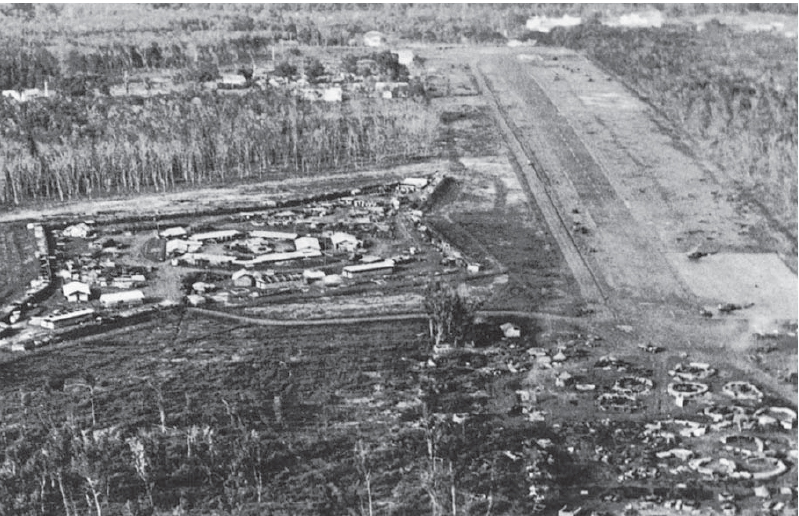
Loc Ninh Special Forces Camp and the district government center near the photograph’s top; the town lies in the upper right corner. The fire support base is in the lower right at the end of the airstrip. It was across this airstrip that 272 Regiment launched their assault.
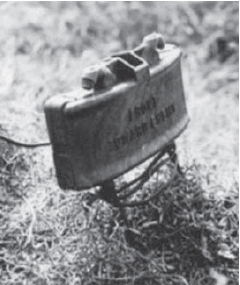
The US M18A1 Claymore antipersonnel mine set up on its folding metal legs, around which the electrical detonating wire is wrapped. The detonator has been removed from this mine, which would have been in one of the two L-shaped fittings on either side of the sight on top. The Claymore was much feared by NVA assault troops.
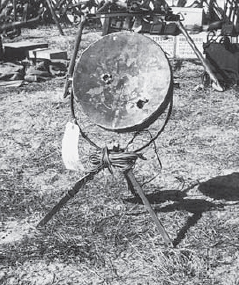
A DH-10 directional command-detonated mine, what the Soviets called a MON-100, mounted on its tripod and with its electrical firing wire attached, which would be connected to an EDP-R electric detonator. It could also be detonated by a pull- or a break-type tripwire. It weighed 11 pounds, was 9in. in diameter and 3.2in. thick. This one has been hit by two bullets from the rear.
Four days later the bunkers and “wire” were completed. The bo doi were surprised at how light the barriers were. There was only a 6.5ft (2m)-high, seven-strand, barbed-wire fence with two stacked coils of concertina and in front of the trenches two more coils. It was explained that the wood posts represented steel pickets and that there was tanglefoot tripwire and Claymore mines between the outer fence and the inner barrier. They were also told to ignore all the trees, though sparse here. Then it was said that the reason the barriers were so light was because beyond the outer fence there was an airstrip runway. The veterans were unhappy with the prospect of crossing almost 100m of bare ground and gravel runway under fire right into Claymores, and they explained what Claymores were and what they did.
During a unit meeting veterans questioned the feasibility of attacking across the runway. The cadre explained that there were fewer machine guns covering the airstrip side of the camp and that an attack would be unexpected there. The other side, facing the rubber plantation had four times the amount of barbed wire and twice as many machine guns.
They practiced a silent approach through the forest and then crossed the area marked as the airstrip, ignoring the trees. Each squad moved as a group in a stooped-over position and in step. This prevented an irregular bobbing effect among the body of men and would be less likely to attract the eye. They were taught to be absolutely silent. No commands would be given as they would do everything in practiced sequence. They were told and rehearsed on what to do in response to enemy actions. If they heard a mortar fire it was probably an illumination flare and they would lie flat and remain still with eyes closed to preserve their night vision. The same would happen with the pop of a trip flare. They would immediately begin moving when the flare burned out. If they were challenged by a sentry they would halt and not move for at least a minute. If there was no further response they would continue moving. If rifle or machine-gun fire opened up they would immediately launch their attack.
In contrast to usual practice, sappers would not go ahead to cut lanes through the wire. Instead, designated squads would cross first and emplace DH-10 command-detonated horizontal blast and fragmentation mines, circular equivalents to US Claymores. The DH-10 would blast a 13–16ft (4–5m)-wide gap though wire. They would also use expedient bangalore torpedoes. When the mines were detonated the rest of the company would rush across the airstrip. Those setting the mines would already be rushing though the gaps with satchel charges and grenades to attack the perimeter bunkers. Some men would carry scaling ladders.
They practiced day and night, with each platoon doing the other platoons’ missions so that any one could be substituted for the other. Every man was able to set up and detonate DH-10s and bangalores. The three-man cells were used for this, with two men carrying the mines or bangalores; the electrical firing wires were already attached to the detonating devices carried by the third man who remained to the rear. Each man practiced being a carrier and firer.
The troops practiced while carrying the equipment they would wear in the assault: an AK-47 with three spare magazines, four stick grenades, canteen and two field dressings. Some men carried wire-cutters to clear unbroken strands, some shovels and others rucksacks full of ammunition cartons and grenades. Everything else would be left in their rucksacks in a hidden site.
Each platoon had its assignment and they talked and walked through it countless times on the model in their base camp. While they practiced breaching the wire time after time, they did not practice what they would do once inside. They knew what each building was. No subunits were designated to attack specific buildings. The veterans knew casualties would be high, there would be utter confusion among themselves as well as the defenders and they would be blinded and dazzled by muzzle flashes, explosions and flares. They were told simply to attack whichever key building they were nearest to, especially the communications bunker, American and Vietnamese Special Forces quarters, mortar pits and ammunition bunkers and to simply shoot at any movement in front of them.
After weeks of preparation the rehearsals ceased. The troops now endured boring days of political and motivational lectures. Supplies of rice, canned fish and ammunition arrived. They knew they would be leaving soon for enslaved South Vietnam. They were to say absolutely nothing of their mission to civilians and non-unit VC they would meet and not even to other companies. They were not even to speak of the mission among themselves unless a cadre was present and in the course of mission preparation.
 |
INFANTRYMAN’S UNIFORM AND EQUIPMENT, SOUTH VIETNAM |
| The dark green uniform was widely worn, but tan and other colors were common. This infantryman (1 and 2) is outfitted to conduct an assault on a Free World firebase. His scarf is made from US cargo parachute cloth and can be used as a camouflage cape by knotting it around the neck and draping it over his back. He is armed with a Chinese Type 56 (AK-47) assault rifle (3). His equipment includes a web belt similar to the US pistol belt (4) and a Chinese-made three-pocket AK magazine chest pouch (5). The chest pouch had three one-magazine pockets and two smaller pockets on both end flaps that wrapped around the torso sides. The small pockets held an oil/solvent container, magazine charging adapter and cartridges in 10-round clips or cartons. Other available equipment comprises a Chinese-made five-pocket magazine pouch (6), Chinese-made plastic canteen (7a, widely used late in the war and carried in a pouch-like carrier) and an old type aluminum canteen with web carrier (7b), four types of stick hand grenades (8, designations unknown except 8a which is a Type 59), four-pocket grenade pouch (9), Chinese 7 x 50 binoculars (10), Soviet compass (11) and sun helmet with a rain cover cut from a plastic sheet and camouflage net, with camouflage parachute cloth bows tied to it (12). |
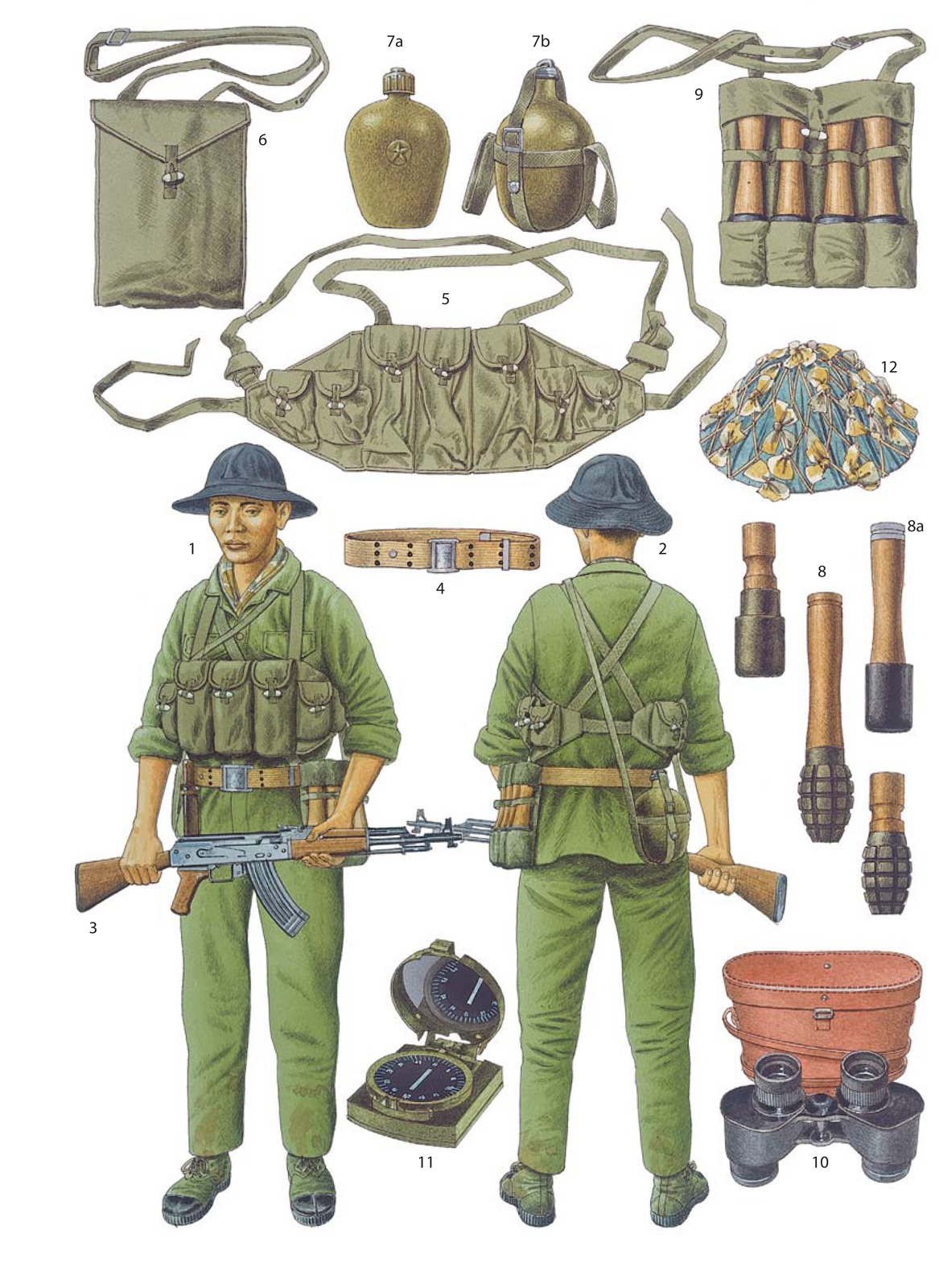
After a hot breakfast they set out after first light. They had expected to join a vast column of troops, but it was two days of marching down jungle trails before they reached an assembly area. They were aware of couriers darting down trails and security patrols were seen. They rested the next day and were told from this point on they would move only at night.
Some of the march was on roads with wide intervals between units, and then they broke off onto trails led by VC guides. They walked from sunset to two hours before sunrise. There was a short break every hour and an hour break around midnight when they ate rice balls and napped. Entering their day’s campsite they dug slit trenches and camouflaged them. A detail cooked rice, and after eating and posting sentries they slept. It was difficult at first because of the reversal of day and night. Sentries were changed hourly. In the heat of midday they had another meal. Water details were sent out, weapons and gear cleaned and more naps were taken through the afternoon. Supper was prepared and eaten with canned fish as the sun set. Rice balls for the coming night’s march were passed out. Slit trenches were filled and they were on the march again. They never knew when they actually entered South Vietnam, but helicopters began to be seen and heard. It was early October 1967.
They established a base camp deep in the forest and there was to be no contact with civilians. There were rumors of agents giving the enemy their plans. They gradually learned what was happening around them. Their regiment and 273 Regiment were somewhere north of Loc Ninh Special Forces Camp and the district government center by the same name. To the south of the camp was 271 Regiment. A couple of weeks after their arrival a battle was reported to the south. Rumors said 271 Regiment had been discovered by the Americans and defeated, with the regiment pulled back to Cambodia after heavy losses. Their company marched for a night and prepared a new camp with increased emphasis on camouflage and security patrols. Porters delivered more ammunition, some of which was hidden in caches closer to the objective. Another model of the camp was built and each platoon went over its mission. The camp was defended by at least 500 Cambodians, Vietnamese, Montaganards and Chinese Nungs advised by about 10 Americans.

Any assault on a Free World base was devastating to the attacking NVA units, even if successful (which was rare). Casualties of 50 percent or higher were common.
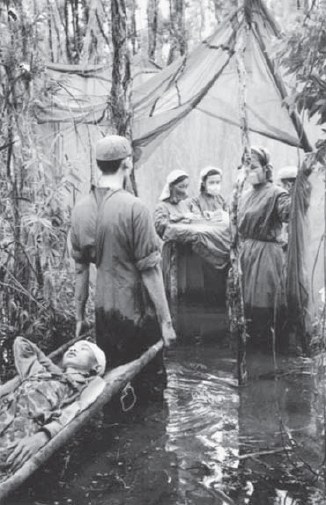
Aid stations were set up in advance of a major assault, not just in the vicinity of the objective, but along the routes back to Cambodia. This swampy surgical station is shaded by a parachute canopy, with mosquito nets providing the side walls.
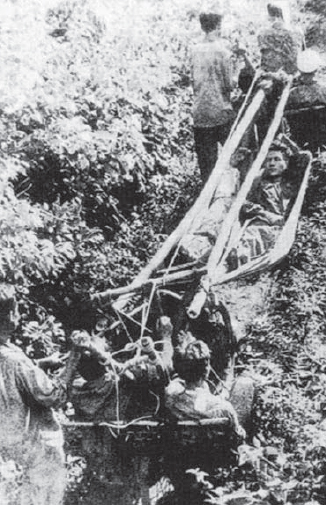
During a major assault, casualties were heavy and the numbers of wounded were staggering. This contraption, comprising two hand-pushed bicycles and horizontal poles bearing two hammocks, also has a pair of seats on both the bicycles allowing four sitting wounded to be transported too.
Late in the afternoon on the 28th, the order was given to move out after sunset. Each man was given nine rice balls and four cans of fish and then filled their rice bags. They moved cross-country in single file, hanging on to the rucksack of the man in front in absolute silence. They found themselves 1.8 miles (3km) northeast of the camp at midnight. Shortly after 1 a.m. the sky to the southwest lit up with heavy mortar detonations and flares. 273 Regiment was attacking Loc Ninh District Town from the west. Then the camp began to be mortared. It was not long before flare ships and gunships arrived to light up the sky and send streams of tracer into the trees. They expected the attack order to come at any moment, but less than two hours later the thundering fire slackened. It continued sporadically until before dawn and then it grew quiet. Scores of helicopters filled the sky at dawn and it was thought reinforcements were being flown into the camp. Later in the morning firing could be heard from the town. The recruits had no idea of what was going on.
There were sharp firefights all day and more helicopters arrived. Word spread that more Americans were being lifted in and were attempting to box them in. There was also speculation that the attack on the camp was delayed to make the enemy believe they had withdrawn. They lay hidden all day. After dark two battalions of 272 Regiment advanced toward the camp and town, and mortars and recoilless rifles were moved into position.
2 Platoon was on the edge of the airstrip peering from the trees at the darkened camp. The men knew that an American firebase had been established at the southwest end of the runway. The tension was almost unbearable. There were flares drifting over the town, but the camp was quiet. They clutched their weapons wondering what would happen, how they would perform, if they would honor their unit and the revolution. Word was passed to prepare.
On order each squad rose and stepped through the trees, with the men crouching. Each of the three cells carrying their DH-10s stepped as quietly as possible on the hard-packed gravel runway then crossed the road. They reached the wire barrier and emplaced the mines a few yards from it. An occasional “tink” or rustling sound increased their apprehension. With equal caution they crept back to where the third man waited with the firing devices. Other cells were still crossing back when the thumps of their mortars firing began to be heard.
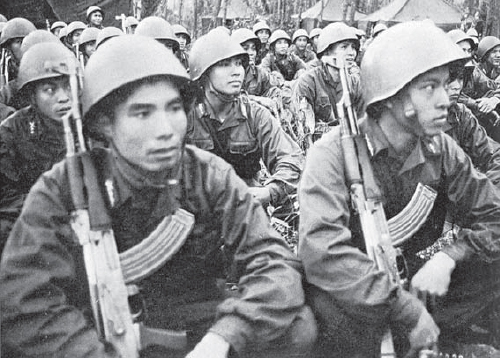
NVA troops undergoing a political indoctrination lecture in North Vietnam in 1972. They wear new dark green uniforms, collar rank insignia, and Soviet steel helmets, and are armed with AK-47 (Type 56) assault rifles.
 |
LAUNCHING THE ATTACK |
| A cell of three bo doi cross the road running parallel to the Loc Ninh Special Forces Camp perimeter wire to emplace two DH-10 directional mines (Soviet designation was MON-100). While it could be used as a Claymore antipersonnel mine and often attached to trees along trails, it was frequently set up on its issue tripod and used to blast gaps through barbed-wire entanglements with 450 steel 10 x 10mm rod fragments backed by 1.79kg of TNT. The third man would drop back with the firing devices, which are connected to the mines by electrical cords. They carry only their assault rifles, four hand grenades and canteens. Most are bareheaded; sun helmets and jungle hats would only restrict vision and even hearing, plus offer a more distinctive silhouette. Their faces and hands are blackened by charcoal. Beyond them is another cell carrying a scaling ladder and wire-cutters. The ladder could be used to bridge wire; it was shoved under concertina wire and then the outer end lifted about 18in. and propped up with Y-shaped sticks. Then a man would crawl under, lifting up the far end and propping it up to create a “tunnel” for the others to follow through. The ladders were also used to carry away any dead and wounded. The assault parties would move in unison to reduce the chance of detection. |

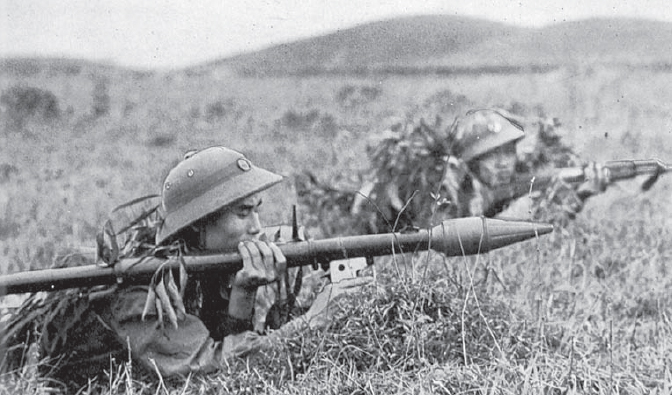
Using local vegetation for camouflage, this sun-helmeted soldier sights an RPG-2 (Type 56) antitank weapon.
The pop of mortars from inside the camp immediately answered, and the mines began detonating with blinding flashes. Momentary silhouettes of bo doi still emplacing mines were seen as others were rushing across the runway with bangalores. Parachute-suspended flares burst overhead shedding yellow-white light. Mortar rounds detonated through the camp in white flashes. The clatter of machine guns erupted all around the camp, spewing out red tracer fire. The sharp cracks of recoilless rifles were highlighted by blazing backblasts among the rubber trees. Whistles shrilled, “Danh tu!” (“Attack!”). Every man was up and running creating tumbling shadows cast by the drifting flares. Streams of green tracers swept into camp from the trees. Men tumbled, staggered and fell. Others were simply knocked flat like limp dolls.
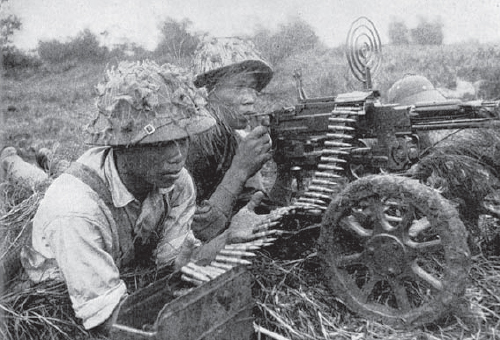
This 7.62mm SGM heavy machine gun crew have camouflaged their sun helmets with camouflage-pattern parachute fabric secured in the netting. The ammunition container held a 250-round, non-disintegrating, metallic link belt. The antiaircraft ring sight is fitted to the gun, but this could also be used against ground targets.
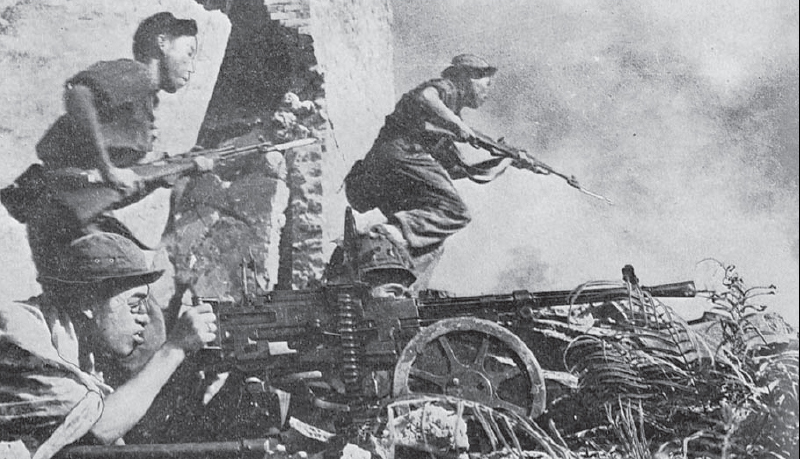
A 7.62mm SGM crew provides covering fire in a posed photo (there are no cartridges in the belt). These heavy machine guns were mainly used as company support weapons. A lighter conventional tripod mount was also available.
The mines had torn broad gaps through the wire. Some trip flares had been ignited by the mine blasts, blinding white sparking glares. They did not pause in their headlong rush even though they felt completely exposed and men were dropping all around. Enemy mortar rounds were bursting on the runway spraying steel and gravel. Something did not look right. They realized the small bunkers and trenches were not at ground level as in their mock-up. They were dug-in atop a 6.5ft (2m)-high berm fronted by concertina wire. Claymore mines detonated in blue-white flashes scything through the bo doi like cut grass.
Two batteries of 105mm howitzers at the firebase on the end of the runway were firing volleys of high-explosive, air burst rounds straight down the strip, blasting apart the attack. Gunships and attack helicopters poured machine guns and rockets into the trees. The attack dissolved.
Some subunits hung on until 9:00 a.m., but most began a confused withdrawal before sunrise. Efforts were under way to recover their wounded and as many dead as possible, along with valuable weapons and equipment, to deny the enemy knowledge of the extent of their losses. Wounded were carried off on scaling ladders, and some of the dead were dragged along by ropes and hooks. A total of 110 men lay dead, left behind in the wire and on the airstrip. Camp defender casualties were very light and no NVA had breached the perimeter. Sporadic contacts were continued around Loc Ninh for two days as the NVA attempted to recover dead and equipment. American battalions had been inserted along the Cambodian border to intercept the reeling 9 Division as it made its way back. Over 1,100 VC/NVA were killed in exchange for a few score Free World casualties. (For further details on the Battle of Loc Ninh, see Osprey Fortress 33: Special Forces Camps in Vietnam 1961–70.)
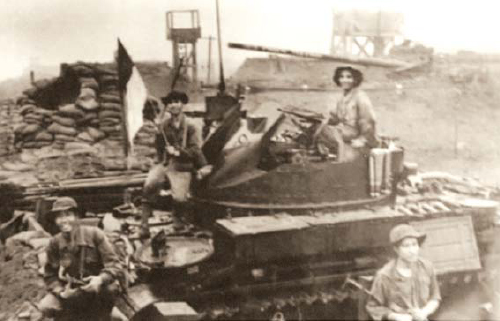
The final victory, 1975. Victorious NVA troops in an overrun ARVN fire support base. The NVA were particularly disdainful of their ARVN enemies who “hid in bunkers like rats,” in contrast to their assaults across open ground and through barbed wire.